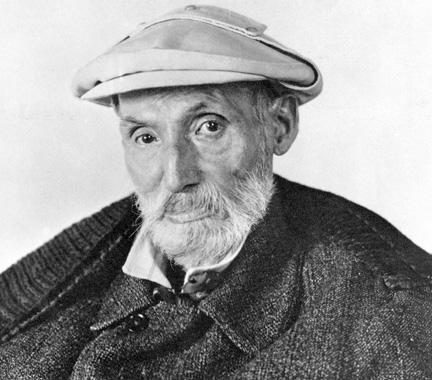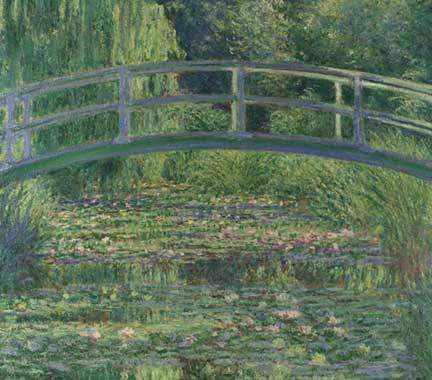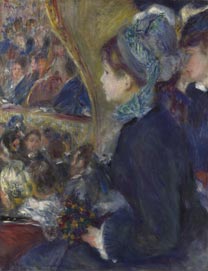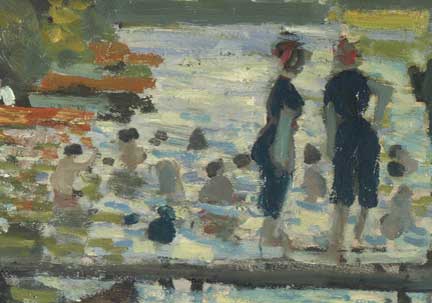The prints of the plates that are displayed below were published in 1864 (first publishment) and are part of the collection of Museo Nacional del Prado museum of the .....Los disparates (The Follies) collection. These were the prints I decided to view.
El caballo raptor (Kidnapping horse)
This is a great example of tone. Look at the way the light is reflected in the background and foreground. The detail is impressive and I never knew as much detail could be achieved in an etching. Looking at the contouring of the horse and fabric of the man you can see a understanding of form. What does work I think is the way he over exaggerates the angles of the bodies. (horses neck etc) I actually feel like saying I Love It. If you close your eyes the light area really do jump out for you. This creates an expressive sense and adds to the dark reality of the overall scene.
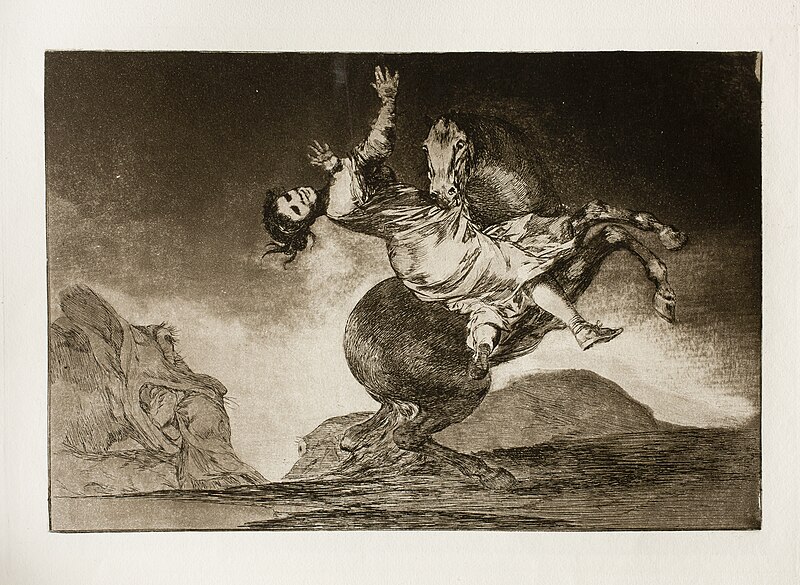
Νο. 10: El caballo raptor (Kidnapping horse), 24,4 x 35,3 cm. (platemark)/33,7 x 50,2 cm. (sheet)
 |
| Νο. 2: Disparate de miedo (Fearful folly), 24,4 x 35,3 cm. (platemark)/33,7 x 50,2 cm. (sheet) |
Disparate de miedo (Fearful folly)
Again another scene that provokes fear and drama (A dream like state almost surrealism style). To think these scenes were a dig at the political world of what was happening in Spain at the time makes you question WHAT DID PEOPLE BELIEVE OR FEAR AT THE TIME? You can feel it......Near the tree in the middle section adds another image that could go unnoticed....alot happening here! Different scratching techniques used or overlaying adding depth and shade
 |
| Νο. 4: Bobalicón (Simpleton's folly), 24,3 x 35,2 cm. (platemark)/33,7 x 50,2 cm. (sheet) |
This one makes me smile a little at the word simpleton! Can you even use this word to describe someone nowadays? It expresses the simple look (mental health) in the giants face and the unknown fear of the situation in the man cowering behind the cloak......The figure behind adds a different sense of ghostly fear.. again the mark making is in-creditable and the tonal value. I do wonder if the scenes are suppose to be night-time scenes of it this was the only way of working at this time? Or to achieve a dark, gloomy effect!
 |
| Νο. 9: Disparate general (General folly), 24,1 x 35,1 cm. (platemark)/33,7 x 50,2 cm. (sheet) |
 |
| Νο. 11: Disparate pobre (Poor folly), 24,4 x 35,2 cm. (platemark)/33,7 x 50,2 cm. (sheet) |
 |
| merry folly |
Look at the detail in the hind-leg of the bull. The merry dancers on the above print. The tones and the way the dark background makes the images jump out almost dancing around the the print. The light reflecting is bold and exaggerated again. The build up and processes must of taken a lot of time and planning. I'm sure a lot of experimenting must of taken place in the years before Goya finished these works. I'm jealous of the dedication artist's seem to have in any work.
Some facts I looked at to get a better understanding of some of the terminology of the printing processes. I will try and create some examples of these in my workbook..... like wax etching or lino cutting... printing on the press or mark marking with different tools and mediums....
This artist reminded me of the etching Picasso had produced years later and that I had looked at last year. The surrealist style. In all the similarities of the power being produced from having no colour. Just line tone and form.
Engraving
In engraving, the grooves which will hold the ink are cut into the copper or steel plate with a burin, a sharp-pointed steel rod set into a handle. The burin cuts a triangular furrow in the plate, cleanly removing a thin strip of metal. The engraver holds the steel rod between thumb and forefinger, pushing the burin with the heel of the hand and altering the direction of the lines by manipulating the plate with the other hand
Considerable effort is required to drive the burin through the metal, and this physical force is reflected in the lines of the engraving, which can be made to swell or taper by varying the pressure on the burin. In addition to the varying strength of the lines, intricate systems of cross-hatching are used for modeling and shading. The engraver may also use the burin to achieve a variety of textures through combinations of dots, tapering cuts, and the like, but the effect is characteristically one of precision and organization rather than spontaneity. The crisp elegance and clarity of the orderly lines are among the particular beauties of engraving.
Dry-point
The soft, feathery lines of drypoint lend themselves to playful illustrations or expressive sketches, which can then produce an edition of prints. Traditionally dry-point is done on copper plates with a diamond- or carbide-tipped needle. It is then inked (as in all intaglio methods) and cleaned, leaving ink only in the crevices. The force of the printing press then squeezes out the remaining ink and the image is transferred onto the paper – this requires tremendous pressure that cannot be applied by hand (hence the necessity of a press).
Etching
In etching, the grooves which will hold the ink are bitten with acid, rather than cut with a tool. The etcher warms a clean, highly polished metal plate [usually copper or zinc] and covers it thinly with an acid-resistant "ground" [composed of asphalt, resins, and wax] using a roller or dabber. The artist draws in the waxy ground with a smooth point or needle that scratches it away, exposing bare metal. When the plate is submerged in a pan of dilute acid, the acid bites into the exposed areas, forming U-shaped grooves.
Several methods exist to create lines of varying strengths. The breadth of the point of the etching needle affects the width of the line, as does the biting time. Perhaps the most common method of controlling the strength of the lines is by "stopping out." The whole composition is drawn at once. The plate is bitten for a certain period of time, then varnish is painted over the lines which are to be light, to stop further biting, and the plate is returned to the acid. Successive biting and stopping out continue until the lines which are to be darkest are bitten to the desired depth.
Aquatint
Aguatint was first widely used in the eighteenth century to imitate drawings done with brush and wash. The technique enables the artist to achieve areas of graduated tones, broader and more even than is possible with etched or engraved cross-hatching.
Traditionally, a powdered resin is dusted onto a clean plate and made to adhere by heating the plate, so that the tiny droplets of melted resin form a permeable coating. In another method, the plate is coated with resin dissolved in alcohol, which evaporates, leaving the resin grains evenly distributed on the plate
Some facts I looked at to get a better understanding of some of the terminology of the printing processes. I will try and create some examples of these in my workbook..... like wax etching or lino cutting... printing on the press or mark marking with different tools and mediums....
This artist reminded me of the etching Picasso had produced years later and that I had looked at last year. The surrealist style. In all the similarities of the power being produced from having no colour. Just line tone and form.
| Picasso - Miotaur etching |
In engraving, the grooves which will hold the ink are cut into the copper or steel plate with a burin, a sharp-pointed steel rod set into a handle. The burin cuts a triangular furrow in the plate, cleanly removing a thin strip of metal. The engraver holds the steel rod between thumb and forefinger, pushing the burin with the heel of the hand and altering the direction of the lines by manipulating the plate with the other hand
Considerable effort is required to drive the burin through the metal, and this physical force is reflected in the lines of the engraving, which can be made to swell or taper by varying the pressure on the burin. In addition to the varying strength of the lines, intricate systems of cross-hatching are used for modeling and shading. The engraver may also use the burin to achieve a variety of textures through combinations of dots, tapering cuts, and the like, but the effect is characteristically one of precision and organization rather than spontaneity. The crisp elegance and clarity of the orderly lines are among the particular beauties of engraving.
Dry-point
The soft, feathery lines of drypoint lend themselves to playful illustrations or expressive sketches, which can then produce an edition of prints. Traditionally dry-point is done on copper plates with a diamond- or carbide-tipped needle. It is then inked (as in all intaglio methods) and cleaned, leaving ink only in the crevices. The force of the printing press then squeezes out the remaining ink and the image is transferred onto the paper – this requires tremendous pressure that cannot be applied by hand (hence the necessity of a press).
Etching
In etching, the grooves which will hold the ink are bitten with acid, rather than cut with a tool. The etcher warms a clean, highly polished metal plate [usually copper or zinc] and covers it thinly with an acid-resistant "ground" [composed of asphalt, resins, and wax] using a roller or dabber. The artist draws in the waxy ground with a smooth point or needle that scratches it away, exposing bare metal. When the plate is submerged in a pan of dilute acid, the acid bites into the exposed areas, forming U-shaped grooves.
Several methods exist to create lines of varying strengths. The breadth of the point of the etching needle affects the width of the line, as does the biting time. Perhaps the most common method of controlling the strength of the lines is by "stopping out." The whole composition is drawn at once. The plate is bitten for a certain period of time, then varnish is painted over the lines which are to be light, to stop further biting, and the plate is returned to the acid. Successive biting and stopping out continue until the lines which are to be darkest are bitten to the desired depth.
Aquatint
Aguatint was first widely used in the eighteenth century to imitate drawings done with brush and wash. The technique enables the artist to achieve areas of graduated tones, broader and more even than is possible with etched or engraved cross-hatching.
Traditionally, a powdered resin is dusted onto a clean plate and made to adhere by heating the plate, so that the tiny droplets of melted resin form a permeable coating. In another method, the plate is coated with resin dissolved in alcohol, which evaporates, leaving the resin grains evenly distributed on the plate

